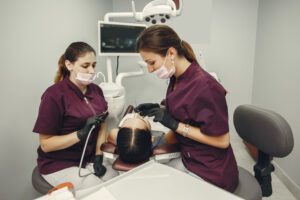Looking for a straight smile can be a challenging task, especially when it comes to Invisalign risk management. Invisalign, a modern orthodontic treatment that uses clear plastic aligners to straighten crooked teeth, has become increasingly popular in recent years. However, as with any dental treatment, it’s important to understand the potential risks and how to manage them effectively.
If you’re considering Invisalign, finding a qualified dentist who can guide you through the process and help you achieve the most satisfactory outcome is essential. This is where a trusted and experienced dentist comes in, who can provide you with personalised guidance and support for your specific needs.
This article aims to provide you with valuable insights into the potential complications of Invisalign and how to manage them safely. You’ll learn about the risks associated with the treatment process and how to mitigate them, including proper care and maintenance of your aligners, regular dental check-ups, and communication with your dentist.
Ultimately, with the right guidance and support for Invisalign safety, you can achieve a straighter smile with Invisalign. So why wait? Start your journey towards a beautiful smile that you can be proud of.

Summary of the Article
Invisalign is a popular orthodontic treatment that uses clear aligners to straighten misaligned teeth. Before starting Invisalign treatment, taking certain steps, such as getting a dental check-up, reviewing your dental history, and discussing any orthodontic issue with your dentist, is important. Proper preparation is crucial for the most satisfactory outcome.
Mild to moderate complications of Invisalign include discomfort and pain during treatment, speech difficulties, and allergic reactions to aligner material. Severe complications include root resorption, TMJ disorders, and inadequate or unsuccessful treatment outcomes.
Following the treatment plan prescribed by your dentist and properly maintaining Invisalign safety is essential. This includes cleaning techniques, wearing the invisible aligners for the recommended time, and adhering to your dentist’s instructions.
If you experience discomfort or pain during treatment, there is Invisalign risk management, such as using over-the-counter pain medication and eating soft foods. Communication with your dentist is also crucial.
After the duration of treatment, wearing retainers and periodic dental check-ups are necessary for long-term success. Identifying and addressing post-treatment issues promptly can prevent relapse and secure the desired outcome.
What is Invisalign?
Invisalign is an innovative orthodontic appliance that offers a discreet and comfortable way to straighten teeth without using traditional braces. This revolutionary restorative treatment uses custom-made, clear plastic aligners to fit snugly over the teeth and gradually move them into their correct positions.
With Invisalign, patients can enjoy a virtually invisible and removable treatment option that won’t interfere with their daily activities. This means no more worrying about food getting stuck in metal brackets or wires, no more uncomfortable adjustments, and no more hiding your smiles behind traditional metal braces.
Invisalign aligners are made from a clear, medical-grade plastic that is smooth and comfortable. They are custom-designed using advanced 3D imaging technology to fit the unique contours of each patient’s teeth for a precise and comfortable fit.
With Invisalign, patients can enjoy the enthusiasm and self-esteem of a beautiful, healthy smile.
Understanding the Potential Risks of Invisalign Treatment
Mild to Moderate Risks
Invisalign has become increasingly popular for its discreet and convenient approach. However, like any orthodontic procedure, there are potential complications of Invisalign to be aware of. Mild to moderate risks are relatively more common than severe risks, which are quite rare. Here are some mild to moderate risks to consider before opting for Invisalign treatment:
- Discomfort and pain during treatment. It’s normal to experience discomfort when wearing Invisalign aligners due to orthodontic tooth movement. You may feel pressure, soreness, or even a little pain as your teeth adjust to each new set of aligners. This discomfort usually subsides within a few days.
- Speech difficulties. Invisalign aligners can temporarily affect speech as your mouth adjusts to the removable aligners. You may experience a slight lisp or difficulty pronouncing certain words at first. However, most people adapt to their aligner trays quickly, and any speech impediments usually disappear within a week or two.
- Allergic reactions to aligner material. In rare cases, some patients may develop an allergic reaction to the aligner material. If you notice any signs of an allergic reaction, such as hives or a rash, immediately discontinue using your orthodontic aligners and contact your dentist.
Severe Complications
While Invisalign is a safe and effective treatment for most people, there are a few risks you should be aware of before deciding whether or not to pursue treatment. Although these severe risks are rare, it is still important to discuss them with your dental professional.
- Root resorption. This is a condition where the roots of your teeth begin to shrink or dissolve, which can cause your teeth to become loose or even fall out. While this is a rare complication, it’s important to be aware of the risk and to discuss it with your dentist before starting your stages of treatment.
- TMJ disorders. TMJ disorders are a group of conditions that affect the temporomandibular joint, which connects your jaw to your skull. These conditions can cause jaw pain and stiffness and may be exacerbated by orthodontic appliances like Invisalign. Again, this is a rare complication, but discussing the risk with your dentist before starting treatment is important.
- Inadequate or unsuccessful treatment outcome. While Invisalign is generally a highly effective treatment for achieving straighter teeth, there are certain cases where it may not achieve the desired results. For example, if you have severely crowded teeth or your bite is significantly off, Invisalign may not be the right option.
Preparing for Invisalign Treatment
If you’re considering Invisalign treatment, it’s important to take the right steps to prepare yourself. Here are some essential things to keep in mind:
- Schedule a dental checkup: Before starting Invisalign, it’s important to ensure that your teeth and gums are healthy. A dental checkup can help identify any issues with your periodontal health that must be addressed before starting treatment.
- Review your dental history: Your dentist will want to review your dental history to see if you’re a good candidate for Invisalign. They’ll also want to know if you’ve had any previous dental work, such as fillings or crowns.
- Discuss any concerns with your dentist: If you have any concerns about Invisalign treatment, discuss them with your dentist. They can help address any worries and provide more information about what to expect during the entire treatment process.
Preparing for Invisalign treatment is crucial in achieving the most desired outcome. It involves key factors that contribute to the success of the entire treatment. Proper preparation confirms that the teeth are ready for the aligners and that the orthodontic patient is fully committed to the process.
Following the Invisalign Treatment Plan
Following the Invisalign risk management plan the dentist prescribes is important to achieve optimal results. Here are some reasons why:
- Consistency is key: Wearing the set of aligners for the recommended amount of time each day is crucial to the success of the treatment. Skipping or forgetting to wear them can result in additional treatment time or less-than-ideal results.
- Avoid setbacks: Failing to follow the treatment plan can result in setbacks, such as repeating a previous phase of the treatment or extended periods of the overall treatment time.
- Protect your investment: Invisalign treatment invests in oral health and appearance. Following the treatment plan ensures you get the most out of your investment and achieve your desired results.
Tips for properly wearing and maintaining Invisalign aligners:
- Wear them as directed: Invisalign aligners should be worn for 20-22 hours per day. Only take them out for eating, drinking, brushing, and flossing. Avoid leaving them out for extended periods.
- Keep them clean: Brush and rinse your aligners whenever you take them off. This helps prevent bacteria buildup and keeps them fresh and clear.
- Don’t use hot water: Hot water can warp the aligners, making them less effective. Always use cool or lukewarm water when cleaning them.
- Store them properly: When you’re not wearing your aligners, keep them in their case. This protects them from damage and keeps them from getting lost or misplaced.
- Follow up with your dentist: Regular checkups with your dentist maintains that your treatment is progressing as planned and allow for any necessary adjustments to be made.
Proper Maintenance of Aligners
Cleaning and Hygiene
Proper maintenance of aligners is crucial for the success of orthodontic treatment and Invisalign safety. It’s important to keep the aligners clean and practice good oral hygiene to prevent complications or damage to the teeth and gums.
Cleaning Techniques for Aligners:
- Brush the set of aligners gently with a soft-bristled toothbrush and a mild soap or detergent.
- Rinse the aligners thoroughly with lukewarm water to eliminate any soap residue.
- Soak the aligners in a denture cleaning compound or a mixture of equal parts water and vinegar for 15-20 minutes, then rinse thoroughly.
- Avoid using hot water, toothpaste, or mouthwash on the aligners, as they can damage the plastic.
Here are some compelling reasons why you should take care of your aligners:
Bacteria buildup: Aligners create an environment for bacteria to thrive, which can lead to bad breath and dental problems. Proper cleaning eliminates harmful bacteria and prevents potential damage to your teeth.
Staining: Without proper cleaning, aligners can become discoloured and unattractive. Clean aligners not only look better, but they are also more comfortable to wear.
Aligner damage: Aligners can be damaged easily if not handled carefully. Avoid exposing them to hot water, excessive force, and harsh chemicals. Proper maintenance secures they stay in good condition for the entire treatment period.
Oral hygiene: Regular brushing and flossing are essential during orthodontic treatment. Proper alignment maintenance helps prevent dental problems such as tooth decay and gum disease caused by food particles left in the teeth and aligners.
Aligner Wear and Compliance
Proper alignment maintenance is essential so that they effectively manage teeth misalignment. Here are some tips to help patients maintain their aligners and achieve the fairest results:
- Wear the aligners for the recommended time: Aligners are designed for a specific period each day. Patients should confirm they adhere to this time to allow the aligners to work effectively.
- Follow the dentist’s instructions: Patients should always follow the instructions given by their dentist when it comes to wearing and maintaining their aligners. This includes instructions on how to clean the aligners, how often to change them, and how to store them properly.
- Keep the aligners clean: Aligners should be cleaned regularly to prevent bacteria buildup, which can lead to bad breath and tooth decay. Patients should use soft-bristled toothbrushes and non-abrasive toothpaste to clean their aligners gently.
- Store the aligners properly: When not used, they should be stored in their protective case. Patients should avoid leaving their aligners out in the open air, as this can cause them to become brittle and break.
- Avoid eating with the aligners: Patients should take out their aligners before eating to avoid damaging or staining them with food particles.
- Wear the aligners consistently: To achieve the most relevant results, patients should wear them consistently and avoid skipping days. Any missed days can result in setbacks in the treatment progress.
Managing Discomfort and Pain During Invisalign Treatment
If you’re undergoing Invisalign treatment, it’s common to experience discomfort, particularly during the first few days of wearing a new set of aligners. However, some strategies can help to manage this uneasiness and make the process as comfortable as possible.
- Using over-the-counter pain medication: Invisalign treatment can cause discomfort and pain, particularly when switching to a new set of aligners. Taking over-the-counter pain medication like ibuprofen or acetaminophen can help to relieve pain and reduce inflammation.
- Eating soft foods: During the first few days of wearing a new set of aligners, it’s better to stick to soft foods that are easy to chew and won’t irritate the gums. This can include foods like soup, mashed potatoes, and yoghurt.
- Applying orthodontic wax: If the aligners are rubbing against the inside of the cheeks or lips, applying orthodontic wax to the affected area can help to reduce irritation and discomfort.
- Using a cold compress: If there is any swelling or inflammation, applying a cold compress to the affected area can help to reduce swelling.
Monitoring Progress
Monitoring the progress of Invisalign treatment is essential to check that patients achieve the desired possible outcomes. Using advanced technology and knowledge, dental professionals can track the movement of teeth and make any necessary adjustments to the treatment plan, confirming that each patient achieves the beautiful, straight smile they’ve always wanted.
Addressing Complications During Invisalign Treatment
Like any dental treatment, potential complications may arise during the Invisalign process. Here are some things to consider:
Complications:
- Loose or broken aligners: Invisalign aligners are designed to fit snugly over teeth, but they can become loose or even break due to excessive wear or tear. This can delay treatment progress or even cause discomfort to the patient.
- Teeth sensitivity: Teeth may become sensitive during treatment due to tooth movement. This can cause discomfort when biting or chewing, and patients may also experience discomfort when wearing the aligners.
- Allergic reactions: Although rare, some patients may experience an allergic reaction to the plastic used in the aligners. Symptoms may include mouth sores, rash or itching.
Steps to take if complications arise:
- Contact your dentist immediately: If a patient experiences any of the above complications, your should contact your dentist as soon as possible. Ignoring these complications can result in prolonged treatment time or even damage to the teeth.
- Keep the aligners safe: If an aligner becomes loose or breaks, patients should keep the aligner and bring it to their appointment to discuss with their dentist.
- Follow instructions: Patients should carefully follow any instructions from their dentist, including taking any prescribed pain relief medication, using orthodontic wax to reduce discomfort, or avoiding certain foods that may aggravate the issue.
Post-Treatment Care and Maintenance
Retainers and Long-term Maintenance
Retainers are essential to Invisalign treatment, and the importance of retainer compliance cannot be overstated.
Types of Retainers:
- There are two types of retainers: fixed and removable.
- Fixed retainers are cemented to the back of the teeth and are not visible.
- Removable retainers are worn over the teeth and can be taken out for cleaning.
Importance of Retainer Compliance:
- Retainers help keep teeth in their new position and prevent them from returning to their original position.
- Failing to wear retainers can result in the need for further orthodontic treatment and can undo all the progress made during Invisalign treatment.
Periodic Dental Check-ups
Patients should follow their dentist’s recommendations and attend regular check-ups to maintain their new smile.
- Securing the long-term success of treatment: Regular check-ups during Invisalign treatment confirm that everything is on track and that the teeth are moving correctly. The dentist can also monitor any potential issues and make required adjustments.
- Identifying and addressing post-treatment issues: After completing the Invisalign treatment, periodic check-ups can help identify any issues that may have arisen. For example, if the teeth have returned to their original positions, the dentist can prescribe a retainer to maintain the teeth’ alignment.
Providing Long-Term Success After Invisalign Treatment
Providing long-term success after Invisalign treatment requires a commitment to good oral hygiene, regular check-ups, and wearing retainers as instructed. By following these strategies, patients can enjoy the maximum benefits of their Invisalign treatment.
Importance of wearing retainers after Invisalign treatment to maintain the results:
- Retainers are crucial in securing that your teeth remain in their new position after the Invisalign treatment.
- After the teeth are moved into their new position, the bone and gum tissue needs time to adjust to the new position, and the retainers help keep the teeth in place until the adjustment process is complete.
Strategies for keeping teeth straight and preventing relapse:
- Regular dental check-ups are essential to confirm that issues are addressed promptly.
- Good oral hygiene practices, including brushing and flossing regularly, can help prevent gum disease and tooth decay that could lead to tooth loss or movement.
- Avoiding hard or sticky foods that can damage the teeth and gums is also important.
- Habits such as grinding or clenching the teeth should be addressed with the dentist to avoid damaging the teeth and causing relapse.
- Finally, wearing the retainers as long as the dentist recommends is crucial, as they will provide ongoing support for the teeth and help maintain their new position.
Final Thoughts
In conclusion, managing risks associated with Invisalign is crucial for achieving a straighter smile safely. As with any orthodontic treatment, risks are involved, but with the proper precautions and guidance from a dentist, the benefits can far outweigh the risks.
Choosing an experienced Invisalign provider is key to reducing the likelihood of complications. Patients should also carefully follow their dentist’s instructions and attend all necessary appointments to confirm that their treatment progresses smoothly.
If you’re ready to take the first step towards a straighter, healthier smile with Invisalign, visit The Smile Space dental clinic today. Our team of dentists are passionate about helping patients achieve their dental goals in a safe and comfortable environment. Contact us now to schedule your consultation and learn more about the benefits of Invisalign.







